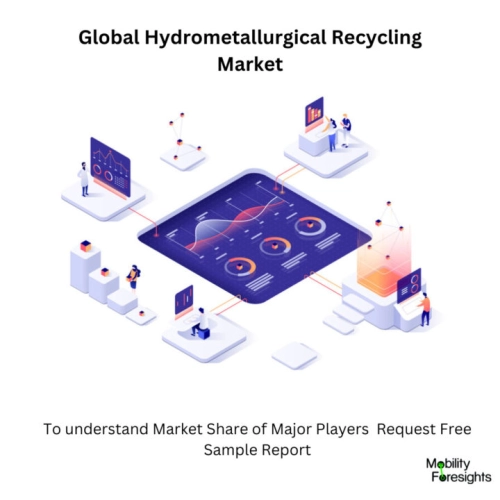
- Get in Touch with Us

Last Updated: Apr 26, 2025 | Study Period: 2023-2030
The hydrometallurgical process, which involves pretreatment, leaching, and metal separation, is an appropriate way to recycle used lithium-ion batteries.
A process of recovering metals from ores and waste materials utilising aqueous media by combining water, oxygen, and other chemical reagents with or without the use of a pressured atmosphere is known as hydrometallurgy.
An illustration is the process of gold cyanidation, which extracts gold from crushed ores using a sodium cyanide solution.
When air is present, the gold dissolves, leaving the non precious residue behind. Hydrometallurgical procedures provide a selective and potentially environmentally beneficial way to separate the metals from the non-metallic components. In this light, a pilot plant was created for the hydrometallurgy treatment of tiny WEEE.
These procedures' major characteristics were pressure leaching in three general temperature ranges: 100â110 °C (below the melting point of elemental sulphur), where elemental sulphur formed; and 150 °C (i.e., above the melting point of sulphur, as in the case of zinc concentrates).

The global hydrometallurgical recycling market accounted for $XX Billion in 2022 and is anticipated to reach $XX Billion by 2030, registering a CAGR of XX% from 2023 to 2030.
The launch of a demonstration facility for recovering and recycling high-value lithium-ion battery (LIB) components such nickel, cobalt, lithium, copper, and graphite has been announced by Electra Battery Materials in Toronto.
The company's refinery complex is where the plant is situated, north of Toronto. Recyclers can rely on PMR when the catalytic converter regulation changes.
Working with an organisation dedicated to responsible sourcing means joining forces with a processor you can trust to support you in keeping your operations legally and morally compliant.
In the demonstration facility, Electra claims it will use its unique hydrometallurgical method to batch-process up to 75 tonnes of black mass material.
It claims to expect the factory to be finished in the first quarter of 2023, at which point it will decide whether to keep processing black mass all year round using materials provided by its partners in business or by other sources.
According to the company, their hydrometallurgical process has a minimal carbon footprint and generates stable non-acid producing residue, both of which lessen environmental effects and meet or surpass water discharge effluent standards as required by both federal and provincial regulations.
The opening of their black mass recycling demonstration plant puts an end to an eventful year for Electra, according to the CEO.
"With the recent passage of the U.S. Inflation Reduction Act and the significant investments made by automotive companies to electrify their fleet, the outlook for electric vehicle adoption in North America is becoming increasingly bullish.
As a result, the need for a domestic supply of battery-grade materials supply, whether through primary refining or recycling processes, becomes critical."
| Sl no | Topic |
| 1 | Market Segmentation |
| 2 | Scope of the report |
| 3 | Abbreviations |
| 4 | Research Methodology |
| 5 | Executive Summary |
| 6 | Introduction |
| 7 | Insights from Industry stakeholders |
| 8 | Cost breakdown of Product by sub-components and average profit margin |
| 9 | Disruptive innovation in the Industry |
| 10 | Technology trends in the Industry |
| 11 | Consumer trends in the industry |
| 12 | Recent Production Milestones |
| 13 | Component Manufacturing in US, EU and China |
| 14 | COVID-19 impact on overall market |
| 15 | COVID-19 impact on Production of components |
| 16 | COVID-19 impact on Point of sale |
| 17 | Market Segmentation, Dynamics and Forecast by Geography, 2023-2030 |
| 18 | Market Segmentation, Dynamics and Forecast by Product Type, 2023-2030 |
| 19 | Market Segmentation, Dynamics and Forecast by Application, 2023-2030 |
| 20 | Market Segmentation, Dynamics and Forecast by End use, 2023-2030 |
| 21 | Product installation rate by OEM, 2023 |
| 22 | Incline/Decline in Average B-2-B selling price in past 5 years |
| 23 | Competition from substitute products |
| 24 | Gross margin and average profitability of suppliers |
| 25 | New product development in past 12 months |
| 26 | M&A in past 12 months |
| 27 | Growth strategy of leading players |
| 28 | Market share of vendors, 2023 |
| 29 | Company Profiles |
| 30 | Unmet needs and opportunity for new suppliers |
| 31 | Conclusion |
| 32 | Appendix |